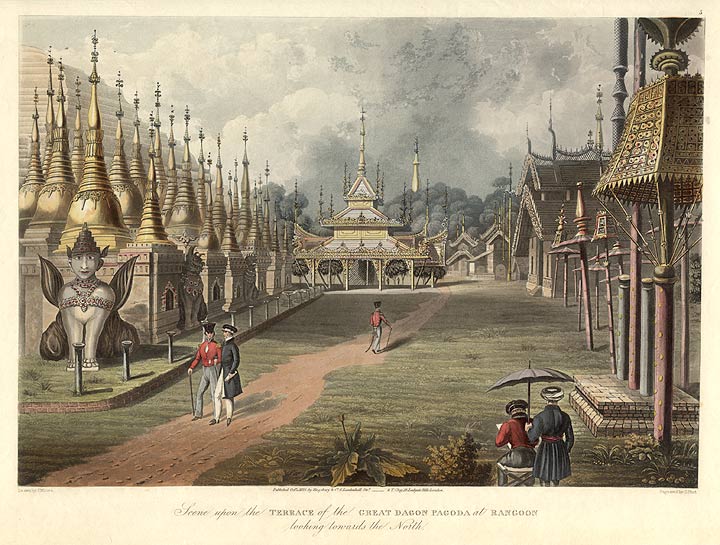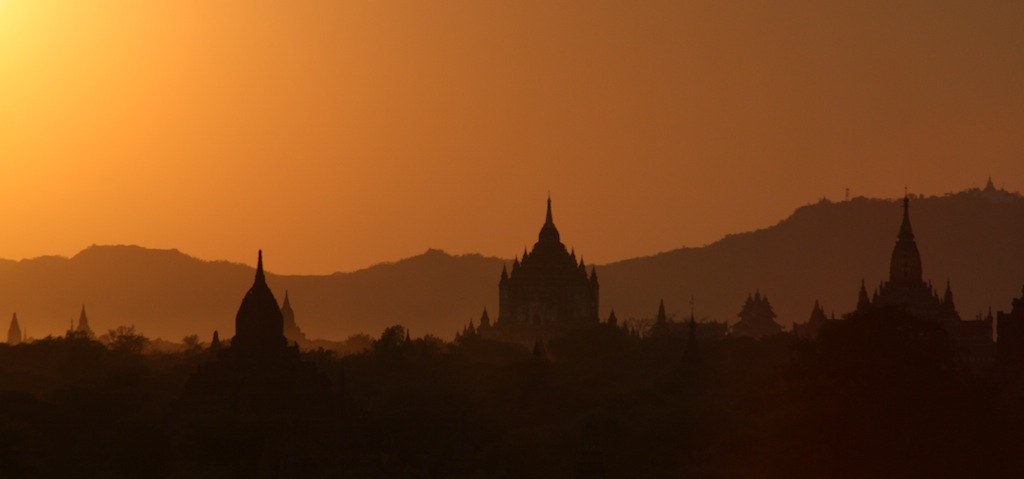|
Möng Yang
Möng Yang (; ) was a Shan state in what is today Burma. It was an outlying territory, located away from the main Shan State area in present-day Kachin State. The state existed before 1400 and after 1604. The main town was Mohnyin (Möng Yang). History Möng Yang was a Shan state established at an uncertain date before the 15th century with the town of Mohnyin as its capital. Sawlon I, the chief of Möng Yang and a descendant of the Möng Mao royal family in 1527, created the Confederation of Shan States which eventually succeeded in capturing Ava, upsetting the delicate power balance that had existed in the area for nearly two centuries. The Confederation originally consisted of Möng Yang, Möng Kawng, Bhamo, Möng Mit, and Kale and raided Upper Burma throughout the early 16th century (1502–1527) and fought a series of war against Ava and its ally Shan State of Hsipaw. The Confederation finally defeated Ava in 1527, and placed Sawlon's eldest son Thohanbwa on the Ava t ... [...More Info...] [...Related Items...] OR: [Wikipedia] [Google] [Baidu] |
Shan States
The Shan States were a collection of minor Shan people, Shan kingdoms called ''mueang, möng'' whose rulers bore the title ''saopha'' (''sawbwa''). In British rule in Burma, British Burma, they were analogous to the princely states of British Raj, British India. The term "Shan States" was first used during the British rule in Burma as a geopolitical designation for certain areas of Burma (officially, the Federated Shan States, which included the Karenni States, consisted of today's Shan State and Kayah State). In some cases, the Lan Na, Siamese Shan States was used to refer to Lan Na (northern Thailand) and Tusi, Chinese Shan States to the Shan regions in southern Yunnan such as Xishuangbanna Dai Autonomous Prefecture, Xishuangbanna. Historical mention of the Shan states inside the present-day boundaries of Burma began during the period of the Pagan kingdom, Pagan dynasty; according to the Tai chronicles, the first major Shan State of that era was founded in 1215 at Möng Ka ... [...More Info...] [...Related Items...] OR: [Wikipedia] [Google] [Baidu] |
Viceroy
A viceroy () is an official who reigns over a polity in the name of and as the representative of the monarch of the territory. The term derives from the Latin prefix ''vice-'', meaning "in the place of" and the Anglo-Norman ''roy'' (Old French ''roi'', ''roy''), meaning "king". This denotes the position as one who acts on behalf of a king or monarch. A viceroy's territory may be called a viceroyalty, though this term is not always applied. The adjective form is ''viceregal'', less often ''viceroyal''. The term ''vicereine'' is sometimes used to indicate a female viceroy '' suo jure'', although ''viceroy'' can serve as a gender-neutral term. Vicereine is more commonly used to indicate a viceroy's wife, known as the ''viceregal consort''. The term has occasionally been applied to the governors-general of the Commonwealth realms, who are ''viceregal'' representatives of the monarch. The position of a viceroy is by royal appointment rather than a noble rank. An individual vicer ... [...More Info...] [...Related Items...] OR: [Wikipedia] [Google] [Baidu] |
Konbaung Dynasty
The Konbaung dynasty (), also known as the Third Burmese Empire (တတိယမြန်မာနိုင်ငံတော်), was the last dynasty that ruled Burma from 1752 to 1885. It created the second-largest empire in history of Myanmar, Burmese history and continued the administrative reforms begun by the Toungoo dynasty, laying the foundations of the modern state of Burma. The reforms, however, proved insufficient to stem the advance of the British Empire, who defeated the Burmese in all three Anglo-Burmese Wars over a six-decade span (1824–1885) and ended the millennium-old Burmese monarchy in 1885. Pretenders to the dynasty claim descent from Myat Phaya Lat, one of Thibaw's daughters. An expansionist dynasty, the Konbaung kings waged campaigns against the Mizo Chieftainship, Lushai Hills, Möng Mao, Manipur, Assam, Kingdom of Mrauk U, Arakan, the Mon people, Mon kingdom of Restored Hanthawaddy Kingdom, Pegu, Siam, and the Qing dynasty of China—thus establis ... [...More Info...] [...Related Items...] OR: [Wikipedia] [Google] [Baidu] |
Sawlon II
Sawlon of Mohnyin ( ; 1486–1533), Tai name Hso Lung Hpa, was saopha of the Shan state of Mohnyin in the early the 16th century. He is best remembered in Burmese history as the conqueror of Ava Kingdom. Sawlon led a confederation of Shan states, and raided Avan territory throughout the first quarter of the 16th century. (The earliest reported date in the Burmese chronicles of a raid led by Sawlon of Mohnyin came in 1502.Maha Yazawin Vol. 2 2006: 103 It is unclear if the Sawlon in 1502 was this Sawlon who would have been only 16 years old, then. The Sawlon in 1502 may have been Sawlon's father.) By the 1520s, his confederation included Shan states of Kale (Kalay), Möng Mit, Bhamo as well as the Burman Kingdom of Prome (Pyay).Fernquest 2005: 348–349 The allies accelerated their concerted attacks on Ava from all directions, and sacked Ava in 1524. But King Shwenankyawshin of Ava and his ally Hkonmaing I of Onbaung–Hsipaw continued their resistance. In 1527, his forces again ... [...More Info...] [...Related Items...] OR: [Wikipedia] [Google] [Baidu] |
Taungoo Dynasty
''taungnguumainn saat'' , conventional_long_name = Toungoo dynasty , common_name = Taungoo dynasty , status = Empire/ Kingdom , event_start = Independence from Ava Kingdom , year_start = 1510 , date_start = 16 October , event_end = Hanthawaddy conquest , year_end = 1752 , date_end = 23 March , event_pre = , date_pre = 1485 , event1 = , date_event1 = 1510–1599 , event2 = , date_event2 = 1599–1752 , p1 = Kingdom of Ava , p2 = Hanthawaddy Kingdom , p3 = Confederation of Shan States , p4 = Lan Na Kingdom , p5 = Ayutthaya Kingdom , p6 = Lan Xang , p7 = Manipur (kingdom) , s1 = Restored Hanthawaddy Kingdom , s2 ... [...More Info...] [...Related Items...] OR: [Wikipedia] [Google] [Baidu] |
Bayinnaung
, title = King of Toungoo , image = Bayinnaung.JPG , caption = Statue of Bayinnaung in front of the National Museum of Myanmar , reign = 30 April 1550 – 10 October 1581 , coronation = 11 January 1551 at Taungoo, Toungoo 12 January 1554 at Bago, Myanmar, Pegu , succession = , predecessor = Tabinshwehti , successor = Nanda Bayin , suc-type = Successor , reg-type = Chief Minister , regent = Binnya Dala (minister-general), Binnya Dala (1559–1573) , succession1 = List of rulers of Lan Na, Suzerain of Lan Na , reign1 = 2 April 1558 – 10 October 1581 , predecessor1 = ''New office'' , successor1 = Nanda Bayin , reg-type1 = King , regent1 = Mekuti (1558–1563) Wisutthithewi, Visuddhadevi (1565–1579) Nawrahta Minsaw (1579–1581) , succession2 = List of Thai monarchs, Suzerain of Siam , reign2 = 18 February 1564 – 10 October 1581 , predecessor2 = ''New office'' , successor2 = Nanda B ... [...More Info...] [...Related Items...] OR: [Wikipedia] [Google] [Baidu] |
Sagaing
Sagaing (, ) is a town in the Sagaing Region of Myanmar. It is located on the Irrawaddy River, to the south-west of Mandalay on the opposite bank of the river. Sagaing, with its numerous Buddhist monasteries, is an important religious and monastic centre. The pagodas and monasteries crowd the numerous hills along the ridge running parallel to the river. The central pagoda, Soon U Ponya Shin Pagoda, is connected by a set of covered staircases that run up the hill. Today, with about 70,000 inhabitants, the city is part of Mandalay metropolitan area, home to more than 1,022,000 inhabitants as of 2011. It is a frequent tourist destination for day trippers, usually as part of the "three former capitals" itinerary alongside Amarapura and Innwa. The city is home to five institutions of higher learning: the Sagaing Institute of Education, Sagaing Education College, Sagaing Technological University, Sagaing University of Co-operative and Management, and Sagaing Universit ... [...More Info...] [...Related Items...] OR: [Wikipedia] [Google] [Baidu] |
Bagan
Bagan ( ; ; formerly Pagan) is an ancient city and a UNESCO World Heritage Site in the Mandalay Region of Myanmar. From the 9th to 13th centuries, the city was the capital of the Pagan Kingdom, the first kingdom that unified the regions that would later constitute Myanmar. During the kingdom's height between the 11th and 13th centuries, more than 10,000 Buddhist temples, Burmese pagoda, pagodas and Kyaung, monasteries were constructed in the Bagan plains alone, of which the remains of over 2200 temples and pagodas survive. The Bagan Archaeological Zone is a main attraction for Tourism in Myanmar, the country's nascent tourism industry. Etymology Bagan is the present-day Burmese dialects#Dialects, standard Burmese pronunciation of the Burmese word ''Pugan'' ( my-Mymr, ပုဂံ), derived from Old Burmese ''Pukam'' ( my-Mymr, ပုကမ်). Its classical Pali name is ''Arimaddanapura'' ( my-Mymr, အရိမဒ္ဒနာပူရ, lit. "the City that Tramples on Enemies ... [...More Info...] [...Related Items...] OR: [Wikipedia] [Google] [Baidu] |
Sithu Kyawhtin
Sithu Kyawhtin (, ; also known as Narapati Sithu (နရပတိ စည်သူ, )) was the last king of Ava from 1551 to 1555. He came to power by overthrowing King Narapati III in 1551, the culmination of his six-year rebellion (1545–1551) with the support of the Shan state of Mohnyin. As king, he was able to get all members of the Confederation of Shan States to unite against an impending invasion by King Bayinnaung of Toungoo Dynasty. He sought a peace treaty with Bayinnaung but was rebuffed. The Ava-led Confederation withstood the initial invasion by Toungoo in 1553 but could not stop a larger invasion a year later. The fallen king spent his remaining years in an estate at Pegu (Bago). He repaid the good treatment by suppressing the 1565 rebellion at the capital while Bayinnaung was away in Chiang Mai. He was given many honors by Bayinnaung. Background Little is known about the background of this king. According to the chronicle '' Zatadawbon Yazawin'', he was an eth ... [...More Info...] [...Related Items...] OR: [Wikipedia] [Google] [Baidu] |
Hkonmaing
Hkonmaing ( , ; also Hkonmaing Nge, Sao Hkun Mong;Aung Tun 2009: 104 1497–1545) was king of Ava from 1542 to 1545. The '' saopha'' of the Shan state of Onbaung–Hsipaw was elected by the Ava court to the Ava throne in 1542, by extension the leader of the Confederation of Shan States, despite strenuous objections by the House of Mohnyin. He was accepted as the leader by other Confederation leaders only because the Confederation was in the middle of a serious war with Toungoo Dynasty. After the Confederation's failed military campaigns in 1543–45 that resulted in the loss of Central Burma, Hkonmaing lost the support of Sawlon II of Mohnyin. He died in 1545 while fighting a Mohnyin-backed rebellion by Sithu Kyawhtin. Background Born in 1497, the future king was the eldest son of Hkonmaing I, the longtime ruler of Onbaung–Hsipaw. His father was the only ally of King Narapati II of Ava between 1505 and 1527 when they unsuccessfully fought against Sawlon I of Mohnyin. H ... [...More Info...] [...Related Items...] OR: [Wikipedia] [Google] [Baidu] |




